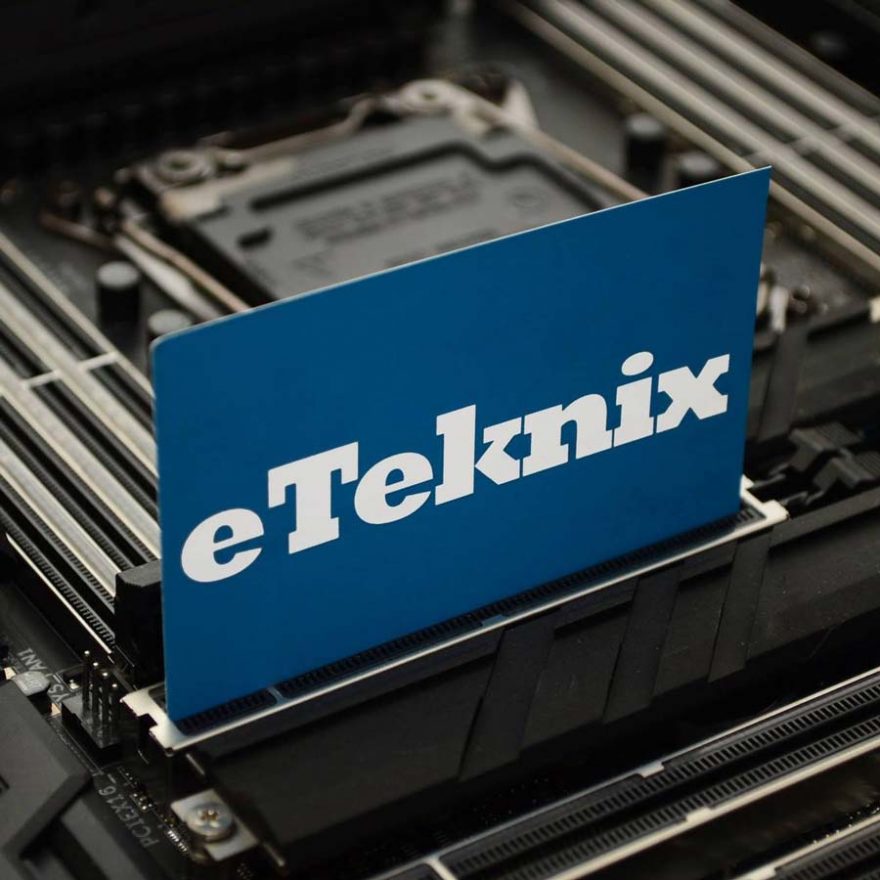SilverStone ET700-MG Power Supply Review
Mike Sanders / 4 years ago
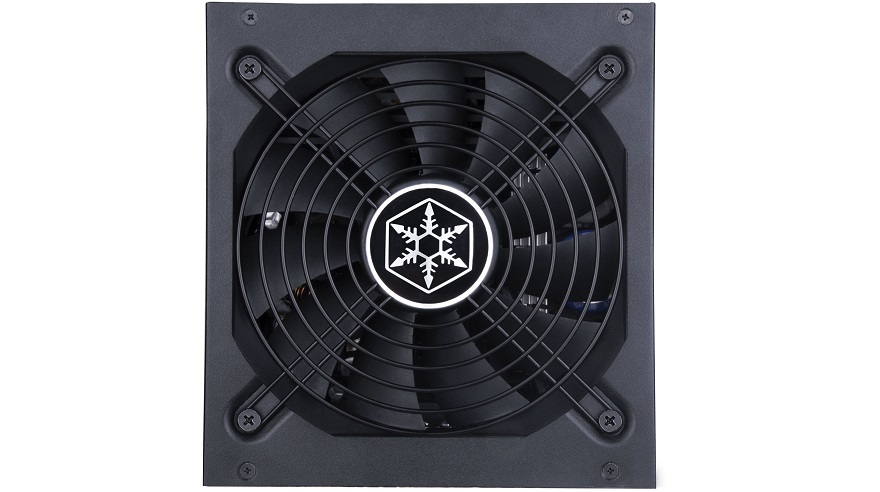
SilverStone isn’t a brand that pings up on our radar often and that is perhaps due to the fact that unlike many other manufacturers, they do not tend to flood the market with products. They seem to rather prefer releasing quality designs in a slow and steady stream. Well, at least that’s the impression I get.
In terms of their past launches, however, we have never failed to be impressed with their power supplies, and with the launch of their brand new ET700, it seemed to pack more than a few excellent features to warrant us giving it a much closer look!
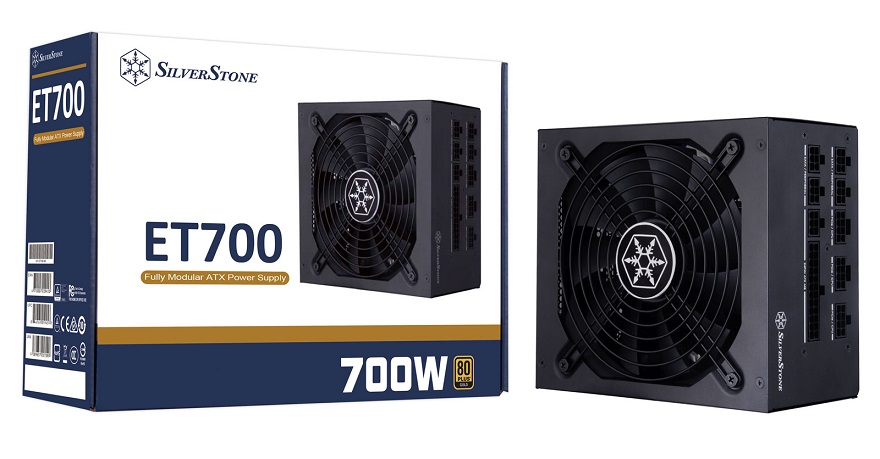
SilverStone ET700-MG Power Supply
Coming with 700 watts of power and featuring an 80-plus Gold efficiency rating, it certainly seems to tick many of the right boxes a savvy PC consumer would (or should) have. More so, with its fully modular cables, this should be a fantastic option for those for value good system design/management. Overall, it looks more than a little excellent.
Just to clarify a point regarding this power supply, however, there is something of a contradiction in the product name. On both on the box work and power supply, it is named as the ET700, whereas the official product name is the ET700-MG. As such, if you see either term used in this review (or with an online retailer), you can safely presume we’re all talking about the same PSU.
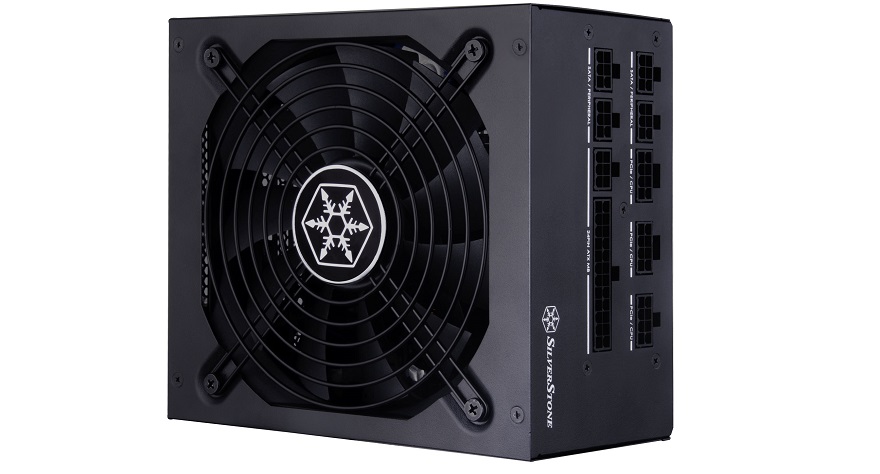
Features
- High efficiency with 80 PLUS Gold certification
- 24/7 continuous power output with 40℃ operating temperature
- Class-leading single +12V rail
- Silent running 135mm fan with 18 dBA
- PCI-E 8pin and PCI-E 6pin connectors support
- Advanced fully cable management
- All-black flat cables design
- Multiple protection circuitry

Specifications
For more details specifications, please visit the official product page via the link here!

Connections
As this is a fully-modular power supply, one of key benefits of this system is only having to install and utilize cabling your PC and components specifically require. While the ET700 isn’t overly generous in the quantity provided, there should still be more than enough here to successfully hook up the vast majority of gaming PCs.

Packaging
The front of the packaging provides you with an excellent image of the power supply that is well contrasted against the bright white background. Providing you with some of the key aspects of its design at a glance, it’s certainly an effective means of getting your attention.
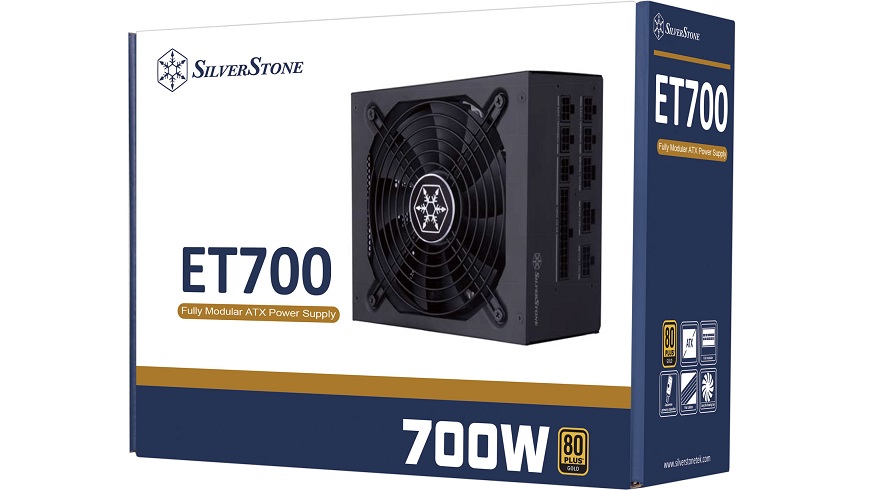
The rear of the packaging goes into more details surrounding the technical aspects of this power supply and, in terms of information provided, it is excellent. Not only are you given a lot of charts, but the manner in which it is conveyed is nice, clear, and very easy on the eye.

Accessories
As this is a power supply, you clearly do not expect to the open the box to find masses of parts. Yes, there are some mad brands out there, but none of them have gone as far (yet) as to release a DIY power supply kit. As such, other than the product manual (which is of a decent quality) and the screws necessary to attach the PSU to your case, you don’t have anything extra, but as above, you don’t really need anything extra!

A Closer Look
Out of the box, the SilverStone ET700 initially presents itself well with it’s sleek black design contrasted well against some of the white highlights noted to the branding sections.

The fan located to the top of this power supply has a strong aesthetic with the SilverStone logo to the centre a clear highlight of the overall design. The fan cover can easily be removed via 4 simple screws that allows for a ‘deep clean’ should it ever be necessary.

While there is some product branding to the sides, it is both well presented and of a size that doesn’t detract from the sleek black look. As noted above, the white highlighted areas really work well on an aesthetic level and overall, I think many would agree that SilverStone has struck a good balance here.

The power input bank is excellent represented with each port being itemized depending on its usage. In addition, with each section well spaced, cable removal and insertion (although a bit stiff) doesn’t provide you with any difficulties.

The rear exhaust vent is fantastically large with open vents to practically all of the area available. This should, all going well, help promote solid airflow and, by proxy, help keep the temperatures down.
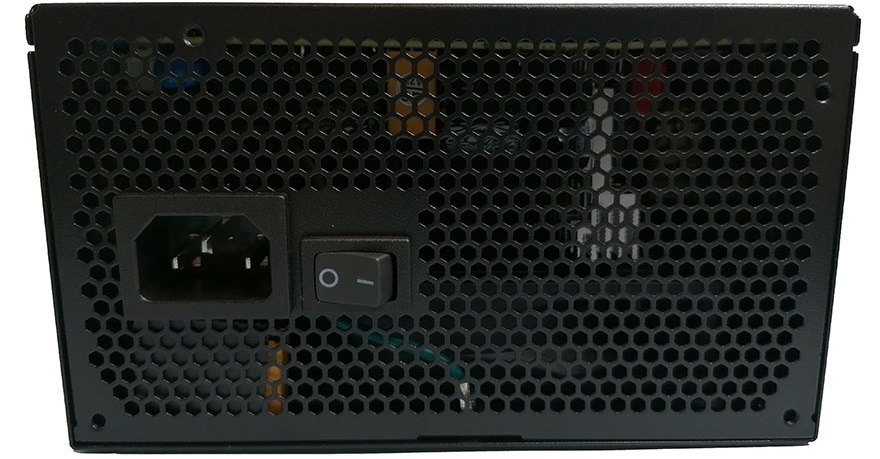
Cabling
Unfortunately, SilverStone does not provide the cabling within any type of packaging and, as such, sits ‘loose’ within the main box. On the plus side, however, the cables are well presented with a significant portion of them being itemized for not only their application, but also with clarification as to which end goes where.
In terms of the length, they are also pretty generous and as such should allow for excellent cable management within even some of the biggest (or unforgiving) PC chassis designs.
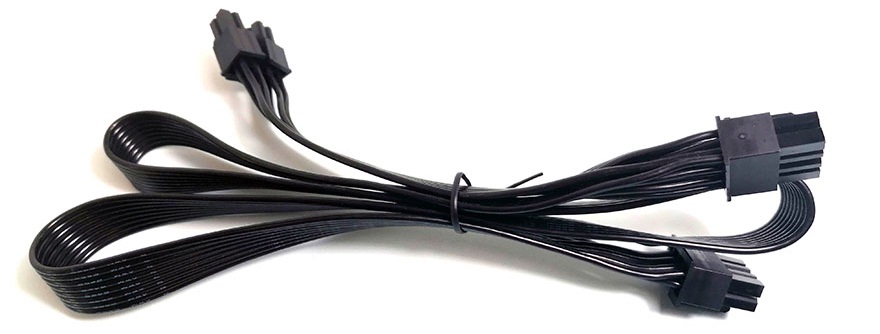
Internals – A Look Inside!
Once inside the SilverStone ET700, the initial impressions are very good. You are not met with masses of cables sprouting from every orifice and, generally speaking, everything looks clean, tidy, and well organized.
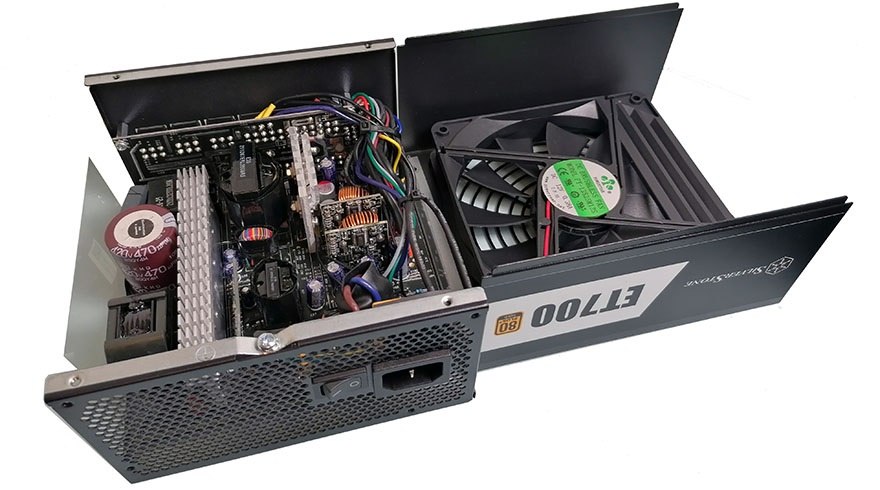
A closer look at the fan sadly finds that this is not a SilverStone own design. That being said, however, many PSU manufacturers often opt for third-party fans as, generally speaking, and unlike a CPU cooler, the fan doesn’t (or shouldn’t) have a particularly taxing job on its hands here.
On the plus side, we have encountered ‘Poweryear’ designs in the past and have never failed to be impressed with their performance.

The PCB is generally well presented with all of the main components well organized and spaced out. In addition, with the heat sinks located in a near central position, this should allow for good airflow based on the fans location when fitted.
Yes, there are a few moderately messy cables at the top, but I promise you that we have seen designs massively worse than this in the past!
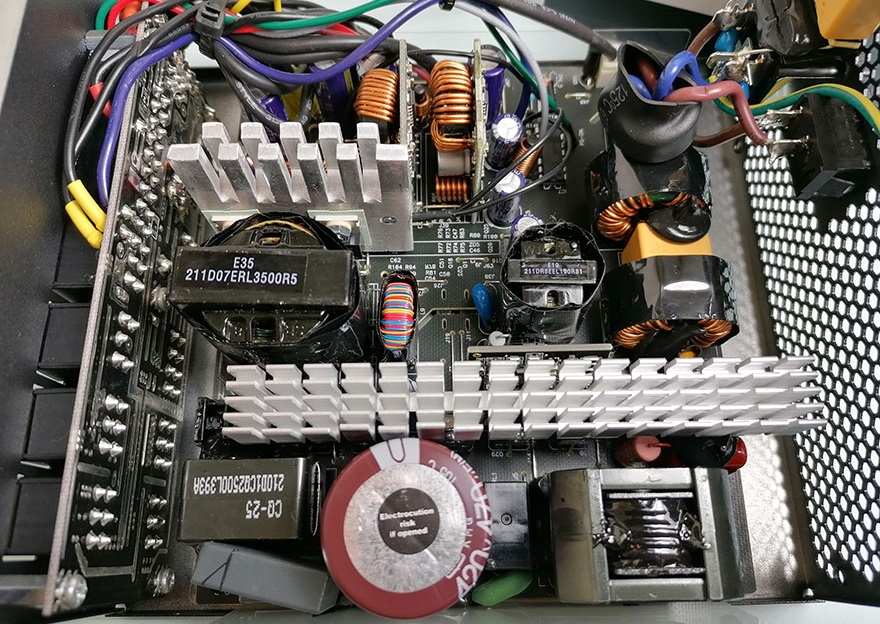
In terms of the capacitors, SilverStone has chosen their words carefully citing that the ET700 has a main Japanese capacitor rather than 100%. What does this mean? Well, while the big capacitor below is indeed Japanese (manufactured by the highly-reputable ‘Nippon Chemi-Con’) the others within this PSU are almost certainly not.
Given that the main capacitor does come from such a reputable brand, however, and the fact that it is rated to 105c, this is exactly what you want to see from this main and highly-important component.
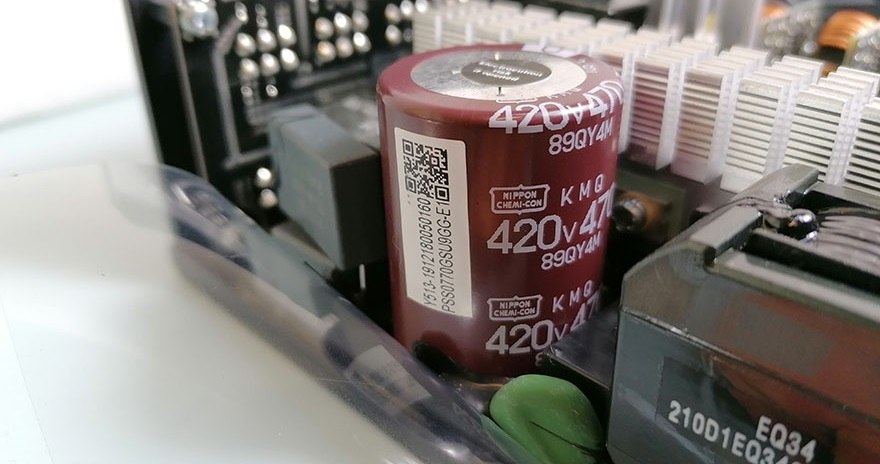
Overall Thoughts!
In terms of aesthetics, while the SilverStone ET700 doesn’t offer much in terms of ‘razzle-dazzle’ it does still carry a very sleek design that is translated well into the excellent organized internal components. Put simply, based on what we can see here, this gives us every belief that this should perform well in our rigerous testing process.
Will it though? Well, there’s only one way to find out! – Onto the testing!
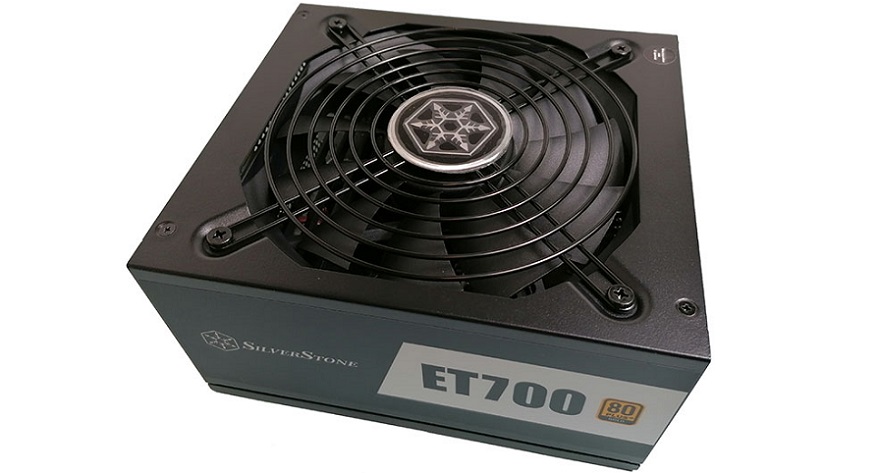
Methodology & Testing
At eTeknix we take the power supply testing procedure very seriously and have invested a lot of resources into acquiring the appropriate testing equipment. For all power supply reviews, we test the power supplies with dedicated power supply testing equipment. This means we are able to get the most accurate results from our testing as opposed to using software benchmarks (such as OCCT) or multi-meter readouts which are broadly inaccurate.
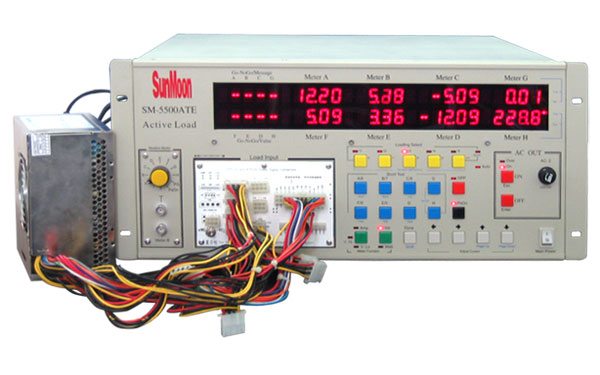
Testing Hardware
- Sunmoon SM-5500ATE Active Load Tester (1200W rated)
- Stingray DS1M12 USB Oscilloscope
- Voltcraft DT-10L laser tachometer
What the eTeknix Test Procedure Involves
- Testing each power supply at 20/40/60/80/100% load (with load balanced across all rails) and measuring PFC (power factor correction), efficiency (actual power divided by power “pulled at the wall”) and voltage regulation (deviance from expected voltages of 3.3/5/12 on the main rails).
- Measuring ripple with an oscilloscope at 20/40/60/80/100% load.
- Measuring fan speed after a stabilisation period of five minutes at each load scenario using the Voltcraft DT-10L laser tachometer and a reflective strip on the fan.
- Testing each power supply’s OPP (Over Power Protection) mechanism and seeing how many watts each power supply can deliver before shutting down
Other Things to Consider
- We recognise that a single 12-volt cable can provide only 6 Amps before overheating (which corrupts voltage regulation and efficiency) and so we used an adequate number of cables for each power supply to ensure there is not efficiency loss from poor cables selection
- Our Sunmoon SM-5500ATE power supply tester is not capable of testing more than 300W on each of the 12-volt rails so where a power supply provides more than 300W on a 12-volt rail that power is distributed over multiple 12-volt rails on the load tester. For example a power supply with one 12 volt rail supplying 750 watts would be spread equally over three 12 volt rails on the load tester, a power supply with two 450W 12v rails would be spread over four 12v rails on the load tester, two 225W 12v rails for each of the 12v rails on the unit.
- We use the same time scale and horizontal millivolt scale on our oscilloscope for all ripple tests, that is a 20ms T/DIV (horizontal) and a 0.02 V/DIV (vertical) meaning the scale is from -80mV to +80mV, ATX spec dictates that the 12v rail must fall within 150mv of ripple and the 3.3/5 within 50mv so that scale allows us to include both 150 and 50mV peaks. (Some older PSU reviews use different scales which were later ditched as the visual representation they give is inadequate, in these reviews written measurements are provided only).
- Deviance is the terminology used to represent the way voltages diverge from the expected values
Voltage Regulation
To test voltage regulation we load the power supply to five different load scenarios that give an equal spread of load across every single rail. So that means 20% on all rails, 40% on all rails and so on. We then calculate the average deviance of each rail from its expected voltage. Ideally, anything of +/- 2% regulation is seen as a very good result.
Power Efficiency
Power efficiency is measured by calculating actual supplied wattage divided by the wattage drawn at the wall/plug, multiplied by 100 to give a percentage. We then compare that to the particular 80 Plus certification the company claims to see if it meets that. You can see the 80 Plus certifications below, we always test power supplies at 230v.
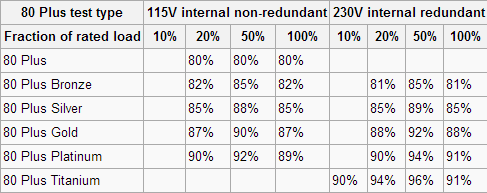
Power Factor Correction
Power Factor Correction is the ratio of the real power flowing to the load, to the apparent power in the circuit. The aim of PFC is to make the load circuitry that is power factor corrected appear purely resistive (apparent power equal to real power). In this case, the voltage and current are in phase and the reactive power consumption is zero. The closer the number to one the better as this allows the most efficient delivery of electrical power (Source – Wikipedia).
Ripple
Noise and Ripple can easily be measured by an oscilloscope. These show how much voltage fluctuation there is on a particular rail. We tested the rail stability of the 3.3-volt, 5-volt and 12-volt rails using an identical time and millivolt scale for all graphs. millivolt ripple is measured by the peak to peak size of the voltage curve.
The latest ATX 12 volt version 2.3 specifications state that ripple from peak to peak must be no higher than 50 millivolts for the 3.3-volt and 5-volt rails, while the 12-volt rail is allowed up to 120 millivolts peak to peak to stay within specifications. Millivolt figures are stated to the closest increment of 5 given their variability.
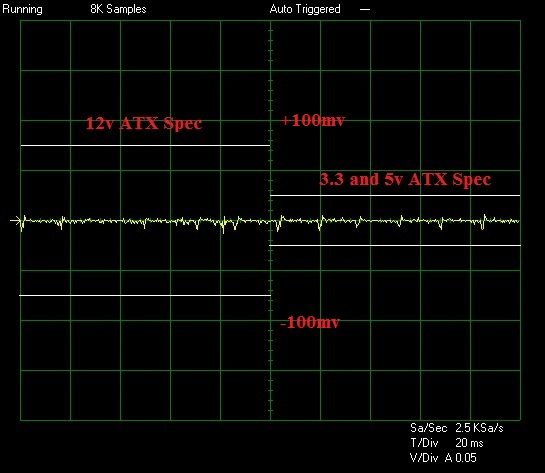
OPP
Power supplies often quote as having various protection mechanisms such and the most important of these is Over Power Protection. In our testing we crank up the power draw until the power supply either shuts down (meaning the OPP mechanism is present and working) or blows up (meaning it is either not present or not working). We then note the maximum power consumption before the power supply shut down, or before it blew up.
Fan Speed
When testing in a power supply laboratory it is difficult to take fan noise readings as the noise from the Sunmoon test equipment and air conditioning corrupts everything. The next best thing in our circumstances was reading off the fan speed with a tachometer to get an idea for the noise. The ambient temperature during testing held constant at 22 degrees, with 1 degree of variation. Each power supply had a consistent time period of 5 minutes to stabilise between each load scenario.
In my experience, the following general relationships apply between noise levels and fan speeds, though it can vary greatly between the type of fan used.
- Below 800 RPM – Inaudible/Silent
- 800 to 1000 RPM – Barely audible
- 1000 – 1200 RPM – Audible but still quiet
- 1200 – 1400 RPM – Moderately noisy
- 1400 – 1800 RPM – Noisy
- 1800 RPM or above – Intolerable
Efficiency
With the Silverstone ET700 being officially specified as having a ‘Gold’ efficiency rating, one of the most critical factors in our testing is checking this to not only see how accurate that description is, but also where the land truly lies in more accurate figures.
Achieving over 90% in all of our tests, this power supply comfortable meets its ‘Gold’ rating and in many respects comes close to Platinum. While it does definitively fall into this category, what we can confirm is that by ‘Gold’ standards, this is on the very high end of the scale.

PFC (Power Factor Correction)
Although starting off a little on the low side, this is neither unusual nor uncommon for the vast majority of power supplies we test. What is important is that as you crank the power output up, that figure should start to increase quite significantly. As you can see below, achieving over 0.95 at 100% is not only what you want to see, it’s actually quite a high score and overall, we find the PFC results very good.

Voltage Regulation
We would concede that the figure provided in our voltage regulation tests give us some of the most ‘mixed-bag’ results we have ever encountered. Across the various power outputs, the figures seemed to show very little consistency and while not concerning, this is certainly unusual and possibly some quirk with the design.
As you might expect, such mildly inconsistent results do provide some unusually high levels of deviancy. Based on the results as a whole, however, we do not find anything overly concerning here.

Ripple
The ripple score determines how cleanly the power is being delivered across the different voltage rails and, as such, lower numbers are always more preferable as, in laymen’s terms, it means that the energy is less excitable. Across all of our tests, the maximum score achieved was 25 which is well below the EU required maximum of 50.
With this in mind, many of the other results (particularly on the 3.3V and 5V rails) are more than a little impressive.
| Load (%) | 3.3V Ripple | 5V Ripple | 12V Ripple |
| 20 | 5.4 | 6.4 | 12.2 |
| 40 | 6.2 | 7.6 | 16.2 |
| 60 | 7 | 9.2 | 16.6 |
| 80 | 8.4 | 10.8 | 20 |
| 100 | 12.8 | 10 | 25 |



Over Power Protection and Max Wattage
Despite being officially rated to 700 watts, it is perfectly normal for power supplies to offer a little headroom above this amount. Largely, to ensure that if the user doesn’t quite get their power consumption maths correct, the PSU can accommodate for a little ‘wiggle room’. What we did not expect, however, was for the SilverStone ET700 to achieve nearly 600 watts over it’s rated value.
This is, quite frankly, an amazingly huge overhead and, just in case it needed confirmation, the OPP’s (to shut down the power supply) worked absolutely perfectly.

Fan Speed
One of the main key factors SilverStone highlights with the ET700 is its near silent performance. During our testing, we found that the fan for this power supply generally ran at a consistent 640-650 RPM and, based on the noise levels this provided, we can categorically confirm that this is barely audible.
Within a system, we doubt you would hear this running at all and, as such, if you value ultra low-noise output, this is definitely well within that remit!

How Much Does it Cost?
At the time of writing, the SilverStone ET700 (or ET700-MG if you prefer) can be purchased for a price in the region of £89.99. In terms of comparative value, this is an excellent price based on the wattage output and Gold efficiency rating that, roughly speaking, has it at least £10 less expensive than many of its competing alternatives.
Performance
Despite some mildly unusual results in our voltage regulation testing, the SilverStone ET700 provided us with excellent results across all of the wide aspects of performance we test. Some of the more stand-out highlights include the much better than it needed to be efficiency results and, of course, that amazingly huge OPP max wattage result.
Based on the highly excellent results we saw, it clearly demonstrates that the SilverStone ET700 is an exceptionally well-designed power supply and, as a purchasing consumers, this should give you not only a solid level of performance, but also the confidence that this has been made to last!
Practicality & Functionality
In terms of funtionality, the SilverStone ET700 is rather basic. As most power supplies generally you. You do not get a hybrid fan mode function and there are no RGB lights to dazzle you. In regards to the former, however, the fan operation is so quiet that I honestly do not think you would notice this running within a system. In regards to the latter, well, the juries still out on whether PSUs really need lighting effects!
With it’s fully-modular design, however, you do have the option to only install the cables you need and with them coming in very generous lengths, cable management within your PC case should be an absolute doddle.
Should I Buy One?
Performing well throughout our testing process, the SilverStone ET700 doesn’t offer much in terms of razzle-dazzle. It is, quite simply, a pretty basic looking power supply. Packing some excellent features, however, a factor that will undoubtedly help tip the consumer scales in it’s favour is that the fact that, comparatively speaking, it’s performs significantly better than a lot of its competition while costing, in many instances, notably less.
Putting all these factors together and while it might not offer that much in terms of aesthetics, who cares about that really when it comes to power supply. You don’t want razzle-dazzle, you want solid and strong reliability and, with those factors in mind, the SilverStone ET700 represents an excellent choice!

